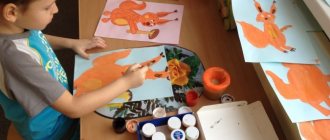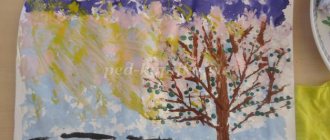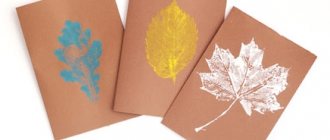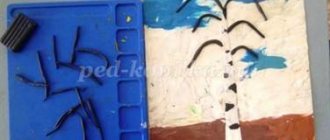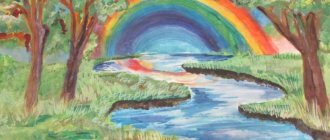Summary of a drawing lesson in the middle group “Birch”
Nadezhda Ogarkova
Summary of a drawing lesson in the middle group “Birch”
Notes on drawing in the middle group
Topic: " Birch "
Program content: Learn to convey in a drawing the characteristic features of the image of a birch; Improve technical techniques for working with a brush; To cultivate aesthetic taste, love and respect for our native nature.
Develop imagination, thinking, imaginative perception.
Illustrations depicting birches , watercolor paints, brushes, drawing , sippy cups.
Summary of the drawing lesson “White Birch” in the middle group
Tatiana Krivonogova
Summary of the drawing lesson “White Birch” in the middle group
Preliminary work: examination of winter landscapes (Shishkin “Winter”
,
drawing “drifts”
using an unconventional method - stamping with a cork, sponge, crumpled paper on blue album sheets.
Equipment: audio with calm music for productive activities.
Demonstration material: sample “Winter Birch”
, display sheet.
Handout: tinted blue album sheets. Gouache paints white , black, 2 squirrel brushes, brush stands, napkins for each.
Motivation and goal setting.
Children sit in a circle.
— Guys, what time of year is it now? (Winter)
— Guys, what do you like in winter?
— The birch tree is especially beautiful in winter - it is a symbol of Russia. Poets praised the birch tree in their poems. Listen to S. Yesenin’s poem “Birch”
(Reading a poem)
.
- This is how S. Yesenin verbally depicted a birch tree in his poem. I liked this poem so much that I wanted to draw a birch tree myself . Look what I got. (Demonstration of finished work)
.
Would you like to draw such a beautiful birch tree ? (Yes.)
- Today in class we will draw our own winter birch tree.
Let's look at the drawing. (Looking at the sample.)
- Tell me, can trees fly in the air? (No, trees grow on the ground.)
—What is the earth covered with in winter? (Snow.)
- So, first we will depict the snowy ground with horizontal wide lines, lines that lie. The result will be a snowdrift.
Progress of the lesson:
Children: Birches .
Children's answers: These trees have white trunks, black spots on the trunks, etc.
Educator: Now I will read you a poem about a birch tree, and you listen carefully.
It will bend and not break.
With leaves in your palms,
Delicious juice, sweet,
A song in the rustle of branches.
And under it what year
Guys, you said everything correctly, birch trees have white trunks, birch trees stand like girls in white sarafans, the leaves are like openwork, silky, and the birch branches are tender . Birch trees are good at any time of the year .
Well, we talked a little about the birch, now I invite you to the tables to draw a birch .
You have everything on your tables to start drawing , but first let's see. how to draw a birch tree .
Finger game "Helpers"
Turn them any way you want.
One two three four five
We took the brushes again.
And they wanted to work.
The children carefully sit down in their seats and get to work.
Educator: You are very good at drawing a trunk , and
The teacher watches the children, if someone is not doing well, he comes over and helps.
Educator: Well done, everyone drew a birch tree , you did a great job, and now we will arrange an exhibition with you.
Guys! How many birch trees did we have, and what is the name of the place where only birch trees grow?
Children's answers: birch grove. Right.
You liked drawing a birch tree . Let's admire and look at our drawings.
Analysis of works: Which works did you like best and why?
“There was a birch tree in the field.” Notes on drawing by dipping a brush for children of the first junior group “There was a birch tree in the field” Notes on drawing (Artistic activities) for children of the first junior group Angela Sorokina, teacher. GCD summary for plasticineography in the middle group “Russian Birch” GCD summary for artistic and aesthetic development (plasticineography) in the middle group. Topic: “Russian birch”. Educator: Guys. Summary of a lesson on unconventional drawing “Amanita” in the middle group Hello, dear colleagues! I bring to your attention a lesson on unconventional drawing “Amanita” for the middle group. Purpose: to give an idea. Summary of the lesson on drawing “Butterflies” in the middle group Hello dear colleagues! I bring to your attention a summary of a lesson in the middle group on unconventional drawing: klyasography, etc. Summary of the drawing lesson “Bullfinch” in the middle group Topic: “Bullfinch” Educational areas: cognitive, artistic-aesthetic, speech. Objectives: introduce the name of birds, their.
Summary of the drawing lesson “Airplane” in the middle group Purpose: to familiarize children with basic information about the origin and development of aviation; enter the words balloon, airplane, into the active dictionary.
Source
MAGAZINE Preschooler.RF
State budgetary educational institution of Moscow "Gymnasium No. 1519" Summary of an open lesson on teaching drawing to preschool children Prepared and conducted by: teacher Samoshkina Elena Gennadievna Moscow 2014 Summary of a lesson on teaching drawing to preschool children. A number of studies devoted to the study of the developmental characteristics of children with mental retardation have noted specific developmental features that complicate the formation of visual activity. Such a disorder is characterized by a lag in the development of the emotional-volitional sphere, higher mental functions, motor sphere, and a decrease in the child’s knowledge and ideas about the world around him. Among such features we can highlight: the qualitative-dynamic originality of gnostic processes (slowing down the reception and processing of sensory information) and underdevelopment of the visual-spatial function; some features of psychomotor development (impulsivity, emotional instability, increased fatigue and exhaustion); lack of sensory integration and coordination makes it difficult to recognize objects and connect individual parts of a picture into a single semantic image; lag in motor development due to problems of muscle tone, immaturity of movement technique, lack of motor qualities, dysregulation of voluntary movements; decrease in the volume of short-term and long-term memory; disadvantages of the voluntary sphere (difficulty concentrating, switching attention, maintaining a task, working according to a model and instructions); general decrease in motivation for activity. Having considered the above-mentioned features of the development of children with mental retardation, it becomes clear that this work should be built using methods of correctional pedagogy and be purposeful. An important feature of teaching children with mental retardation is an integrated approach, which should include several areas: - diagnostic study of the child upon admission to the group to establish the characteristics of his development, clarify his starting capabilities and determine the learning conditions adequate to the structure of the disorders; establishing feedback with the pupil’s family for the purpose of consulting and collecting additional data about the child; interaction with a neurologist (psychoneurologist) to monitor health status; organizing classes according to a combined principle in such a way that several diverse tasks of development, education and training are solved within the framework of one lesson; conducting differentiated training, preliminary individual assistance before group classes, differentiation of assistance within the group; building training on a concentric principle; use of game motivation in all classes; control of psychophysical load both in intensity and duration, and in the sequence of presentation of tasks (intellectual and motor load, phases of active work and relaxation). When teaching children with mental retardation of preschool age, it is important to take into account their age and specific characteristics; the leading role in training should belong to the teacher. Theme “Autumn Birch” (preparatory group) Program objectives: continue to teach children to understand the content of the story. To develop children's attention and observation skills. Activate children's speech with figurative expressions and comparisons. Practicing the skill of question-and-answer speech. Practice relieving tension and being able to relax. Educational work. Learn to convey in a drawing the characteristic features of a birch (white trunk with black spots, thin curved branches, light crown), autumn color of foliage; teach the correct methods of using a semi-dry hard brush when drawing vertical strokes to depict foliage and horizontal strokes to depict black spots on a birch trunk; consolidate the skills of drawing thin curved lines with the end of a brush; through riddles, illustrations, drawings, to form in children’s minds the image of a slender white-trunked birch. Material. The teacher has an illustration with a picture of a birch, a sheet of paper to show individual methods of depiction, two brushes - soft and hard, and paints. Children have blue paper of saturated color in the form of an elongated rectangle, additional sheets of white paper for exercises in drawing thin lines and different ways of working with a hard brush; soft and bristle brushes, gouache paints. Progress of the lesson. The teacher hangs an illustration with a picture of a birch with the back side facing the children and says: “In this picture there is a tree that we will draw. But we’ll look at it after you guess two riddles about it.” A Russian beauty is standing in a clearing in a green blouse and a white sundress. When the children name the answer, he asks: “What is the name of the birch tree in this riddle? Why is she called a Russian beauty? What is the name of the birch tree's green blouse? What about a white sundress? Now listen to the second riddle: Alena is standing: green scarf, slim figure, white sundress. This riddle indicates another sign of birch - “thin figure”. What do you think is meant by these words? (A thin, tall trunk.) And what beautiful girl’s name is the birch tree in this riddle? Why is the birch tree often compared to a slender, tender girl in riddles, poems, and songs?” The teacher shows an illustration of a birch tree and asks the question: “What kind of birch tree did the artist depict?” List together with the children all the features that they will reflect in their drawings: a white transparent trunk with black spots, thin curved branches, a translucent crown with yellowed leaves. He says: “Today you will draw an autumn birch tree as the poet depicted it in his riddle poem, as you saw it on a walk. And in order for it to turn out like this, you must first learn to depict some of its parts on a white sheet of paper. Let's start by drawing thin, flexible, curved branches, tilted in different directions." The teacher shows and explains how to draw the branches of a birch: “Like other trees, the branches grow upward from the trunk, but then smoothly round and fall down.” He suggests using the end of a soft brush to draw several branches inclined to the right and left. The exercise can be done under the words “up, and round, and down” (pronounced drawlingly). Then the teacher exercises the children in depicting foliage using a vertical stroke with a hard brush. First, he shows how to take a little green and yellow paint, wipe off the excess on newsprint, and with quick movements, holding the brush vertically to the paper, paint the foliage so that the gaps between the strokes are visible. The next exercise helps children master the technique of drawing strokes with a semi-dry hard brush to depict spots on a birch trunk. He suggests looking at the illustration of a birch again and starting drawing. In the process of drawing, if necessary, it resembles the techniques of depicting a trunk, starting to work with the tip of the brush and gradually lowering it to a flat position. Asks about the length of the branches at the top and bottom of the tree. The color of birch foliage at the beginning of autumn may be partially yellow. Draws children's attention to the outlines of the birch crown. The teacher encourages children for making interesting additions to the drawings. He asks if it is possible to depict the grass under the birch tree with strokes of a hard brush. At the end of the ringing, the teacher encourages all the work and makes another riddle about a birch tree and suggests finding among the pictures the one that best matches the description: Wearing a white sundress, we stood in a clearing. The tits flew and sat on their braids. He asks which birch tree has braids - long hanging branches. Then several more drawings are examined in order to “find a birch tree that can be compared with a slender Russian beauty.” The teacher notes drawings with interesting additions that enrich their content. Relaxation exercise. a) “Fists” b) “Let’s inflate a balloon” c) “Magic dream”| Next > |
Summary of a drawing lesson in the middle group “White Birch”
Svetlana Mukhambetyarova
Summary of a drawing lesson in the middle group “White Birch”
Lesson summary for the secondary drawing group
on the topic: “ White birch ”
Goal: To conduct educational activities for children in an interesting way. Create conditions for conducting the lesson .
Objectives: Through riddles, music, paintings, to cultivate interest in the figurative perception of the beauty of nature and its transmission in drawing, the ability to purposefully examine, see color and shape in nature.
Develop the ability to harmoniously arrange a drawing in paper format, listen carefully to the teacher and correctly carry out his instructions.
Instill accuracy when drawing . Strengthen brush skills and techniques.
Introduce you to the world of classical music.
Foster independence and interest in visual arts.
Equipment: Black and green gouache, 2 brushes: soft brush and hard bristle brush No. 6; a white A4 sheet, a jar of water, napkins, brush stands, classical music, a recording of the sounds of nature, a painting “Forest”
.
Preliminary work: Reading fiction, asking riddles, looking at paintings. Introducing children to the “poke” drawing
.
Excursion around the entire kindergarten site, observing nature. Didactic games “Recognize and name the tree”
,
“Seasons”
,
“Guess by description”
. Learning poems and round dance songs.
Methods and techniques of work: conversation, looking at pictures, imaginary situations, questions for children, choral and individual answers, display: visual, verbal, analysis of children's works, surprise moments.
Vocabulary work: enrich children's vocabulary: beauty, white-trunked, slender, lentils.


